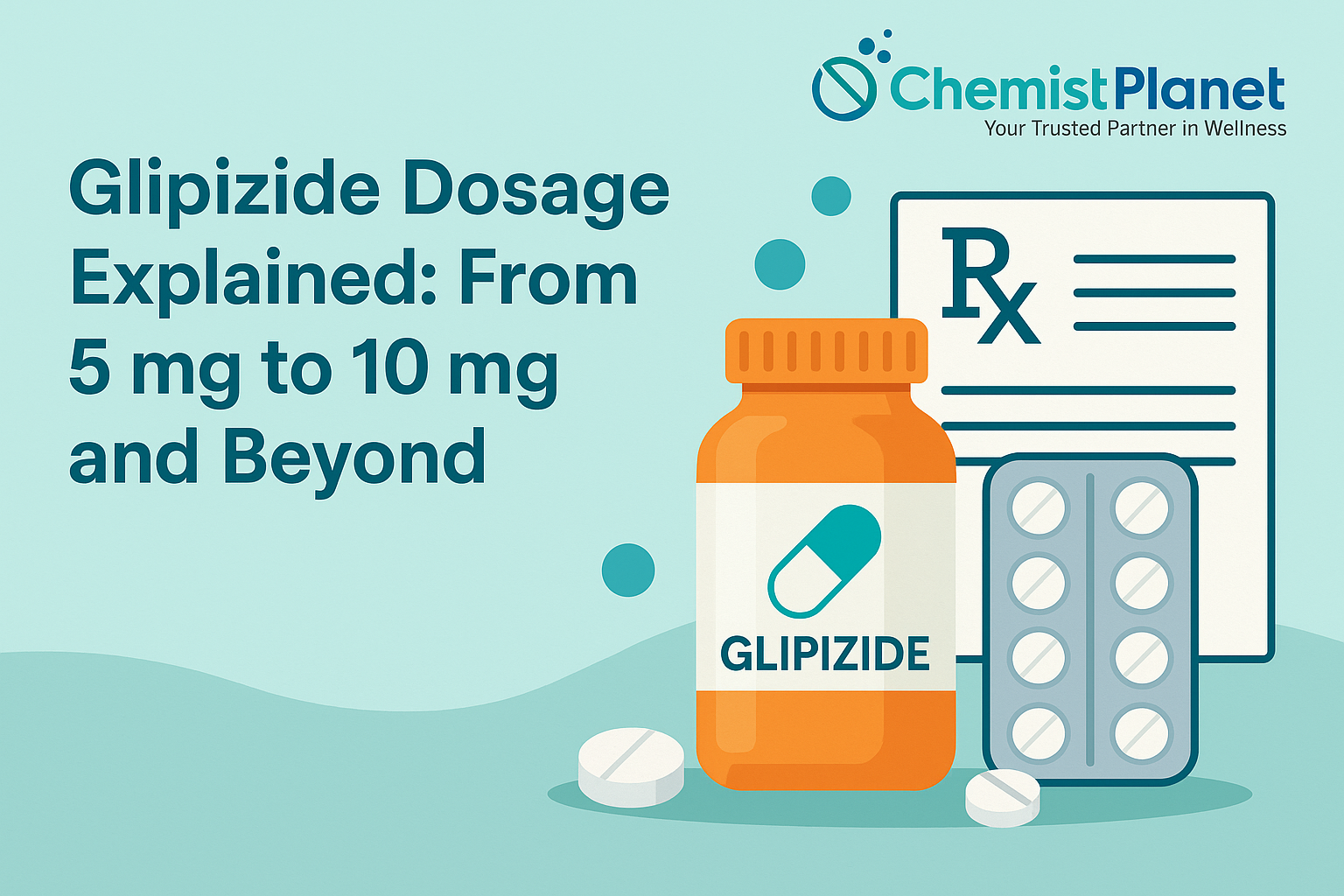
Glipizide Dosage Explained: From 5 mg to 10mg and Beyond
Dealing with type 2 diabetes might seem like a daily balancing act. Every action, from food and exercise to medicine, is absolutely vital in maintaining blood sugar levels. Often recommended for this ailment is Glipizide—a reliable oral diabetic treatment that has benefited many. But how much Glipizide should you take? From 5 mg to 10 mg and beyond, let’s investigate Glipizide dose in depth so you may feel more knowledgeable and empowered on your diabetic path.
Glipizide is-
Primarily used to reduce blood sugar levels in those with type 2 diabetes, Glipizide is a second-generation sulfonylurea. It works by encouraging the pancreas to produce insulin, a hormone that helps control blood sugar. Glipizide is a tablet form unlike insulin injections, therefore it is simpler to include into your regular schedule.
Usually taken once or twice a day before meals, Glipizide is available in generic form as well as under brand names as Glucotrol.
Beginning Dose: 5 mg Glipizide
Doctors often advise a low beginning dose for most persons beginning Glipizide to see how the body reacts. Usually, the beginning dose is:
- Once daily, 5 mg taken around 30 minutes before breakfast.
- Especially for new users or those with sensitive systems, this beginning dose helps lower the possibility of hypoglycemia (low blood sugar), a possible adverse effect of Glipizide.
- Sometimes, particularly for older individuals or those with liver issues, the doctor may begin with an even lower dose of 2.5 mg.
- Always take Glipizide before meals to assist coordinate insulin generation with dietary consumption, hence lowering blood sugar surges.
When is the dose increased?
- Your doctor could evaluate your blood sugar levels and determine whether the dose has to change after several days or weeks on the first dose.
- Should blood sugar stay elevated, the dosage could be progressively raised in 2.5 mg or 5 mg increments every few days or once a week.
- For many individuals, the typical effective dosage is 5 mg to 10 mg per day.
- To prevent low sugar episodes, the maximum advised daily dose is 40 mg divided into two doses: morning and evening.
- Important: Your Glipizide dose should not be changed without first seeing your doctor. Age, renal function, lifestyle, and other drugs all affect individual requirements.
The Usual Maintenance Dose is 10 mg Glipizide.
- When paired with appropriate diet and exercise, many type 2 diabetes patients find that a 10 mg dosage of Glipizide efficiently controls their blood sugar.
- Often, this dosage is recommended in one of two ways:
- Before breakfast, take 10 mg once a day.
- For more consistent glucose management, 5 mg twice daily—once before breakfast and once before supper.
- Especially for people who have developed some tolerance to the drug, this dose provides a compromise between effectiveness and safety.
Real Talk: Your dose may fluctuate with time; don’t be disheartened. Managing diabetes is dynamic; as you age, your needs could vary with weight changes or lifestyle changes.
Formulations of extended-release (ER)
Usually used once daily, glipizide is also offered as extended-release pills. These ER versions—such as Glucotrol XL—help to keep consistent blood sugar levels by providing a constant flow of medicine all day.
Common ER doses are:
- 5 mg or 10 mg daily with breakfast.
- Maximum ER dose: 20 mg daily.
- For those who desire less blood sugar variation and like to take their medicine once a day, extended-release formulations are perfect.
Pro Tip: ER pills are meant to deliver medicine slowly so don’t crush or chew them.
Beyond 10 mg: Higher Doses and Caution
The doctor may raise the dose gradually—up to the maximum of 40 mg/day for those who do not reach goal blood glucose levels on 10 mg. Higher dosages, nevertheless, raise the risk of:
- Low blood sugar
- Increase in weight
- Digestive problems
Sometimes, rather than increasing the Glipizide dose, your doctor may choose to mix Glipizide with additional drugs such Metformin or insulin.
Always tell your physician your whole medical past. Some diseases, such as renal or liver illness, can call for dosage changes or other therapies.
Important Safety Advice
- Take Glipizide always before meals.
- Steer clear of alcohol since it might raise low blood sugar risk.
- Especially following dose changes, keep an eye on your blood glucose.
- Watch for symptoms of hypoglycemia—dizziness, perspiration, shakiness, or disorientation.
- Keep your medicine in a cool, dry area away from moisture and sunlight.
- Missed doses should be taken as soon as you recall unless they are near your next meal; then skip them. Don’t ever double up on dosages.
Last Reflections:
Personalized Diabetes Care Is Important
Diabetes control is personal, as Chemist Planet knows. Though Glipizide—ranging from 5 mg to 10 mg and beyond—is a potent weapon for many, there is no universal answer. Your health objectives, way of life, and how your body reacts to therapy will determine the appropriate dose for you.
Before altering any drug, always check with your doctor. And keep in mind that drugs perform best when combined with frequent check-ups, physical activity, and good food.